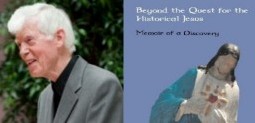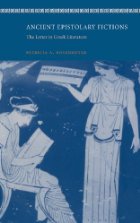 Continuing the series on Thomas Brodie’s Beyond the Quest for the Historical Jesus: Memoir of a Discovery, archived here.
Continuing the series on Thomas Brodie’s Beyond the Quest for the Historical Jesus: Memoir of a Discovery, archived here.
Chapter 16
PAUL: THE PENNY FINALLY DROPS
The last post in this series concluded with
If Brodie’s analyses are correct then it is clear that
the epistles and Luke cannot be taken at face value in writing a life of Paul. (p. 144)
One thing is clear. In recent years there has been a growing interest in literary analysis of the Bible and an increasing awareness of the use of the Septuagint in the composition of the New Testament works. And if literary analysis increasingly sheds light upon the Septuagint as a source of the epistles and Acts, reconstructing the life of Paul must become increasingly difficult.
So who or what was Paul and where did this character come from?
For Brodie, the answer hit him (“with a shock”) in 2008 after years of absorbing the contents of the work of Robert Alter, The Art of Biblical Narrative. To see Brodie’s thoughts on his first encounter with Alter’s work return to Act 3, Scene 1 (Too Strange!). In one of those light-bulb moments it suddenly occurred to Brodie that almost every chapter of Alter’s book aptly explained the New Testament epistles.
Like Hebrew narrative, the epistles are reticent. And composite. And repetitive. And, standing out from the list: like Hebrew narrative, the epistles are historicized fiction.
Historicized fiction.
A mass of data had suddenly fallen into place.
What hit me was that the entire narrative regarding Paul, everything the thirteen epistles say about him or imply — about his life, his work and travels, his character his sending and receiving of letters, his readers and his relationship to them — all of that was historicized fiction. It was fiction, meaning that the figure of Paul was a work of imagination, but this figure had been historicized — presented in a way that made it look like history, history-like, ‘fiction made to resemble the uncertainties of life in history’ (Alter 1981:27). (p. 145)

No doubt some will dismiss such an idea as unrealistic but to those people I would highly recommend reading Patricia Rosenmeyer’s Ancient Epistolary Fictions — some critical details are discussed in an earlier post. (Brodie does not list Rosenmeyer in his bibliography.) Brodie refers to other known cases of epistolary fictions: the letters between Paul and Seneca, as well as more recent examples.
My own thoughts in response to Brodie’s view is that such a Paul would explain how it was so easy for so many different Pauls to appear, each one representing a different type of Christianity. We have more than one Paul represented in the canonical epistles. We have another Paul in Acts; and another in the Acts of Paul and Thecla. And so forth. The many Paul’s appear to have been sculptured out of various theologies, not biographical memoirs.
Brodie nonetheless wants to emphasize that such a notion does not mean Paul has no value for the faithful. The Good Samaritan is a fictitious character but represents an inspiring “truth”. Similarly, Paul remains an inspiring character who captures the essence of Christianity. Brodie quotes C. Martini (The Gospel According to St Paul):
Paul is a representative figure for all of Christianity. (Martini 2008:15)
Paul is a figure to be imitated, a model for the faithful. Christianity is encapsulated in his persona. There may have been an inspiring figure on which the literary person was based, but that historical person is not the literary one.
Brodie was not the first to come to this view. Bruno Bauer had also concluded that both Jesus and Paul had been “non-historical literary fictions”. Bauer’s doubts were taken up by many of the radical critics among the “Dutch, French, Anglo-Saxon scholars at the end of the nineteenth and the beginning of the twentieth century”. Brodie intimates that their doubts faded from the scene because their methods were largely undeveloped. (I’m not so sure that their views were sidelined because of criticisms of their “methods”. Brodie is surely being very optimistic in relation to his peers.)
.
Paul as a Literary Figure – Direct Evidence from the Epistles
1. Authorship
It is now widely accepted that Paul did not write all the letters attributed to him in the NT.
Once the principle is established that Paul’s name, plus details about his life, do not necessarily establish the historicity of Paul, then the road is open for further questions about his historicity. (p. 148)
I’m thinking now of 2 Timothy where the author names those who have deserted him, and those who have remained with him, and asks Timothy to bring him a cloak and some parchments — yet all of this must necessarily be fiction if 2 Timothy were not authored by Paul. Compare how so many Bible scholars and others insist that “realistic details” are a sure sign of historicity in relation to the Gospels and Jesus. (And those details in 2 Timothy are precisely the sorts of details that Rosenmeyer demonstrates were part and parcel of epistolary fictions to lend them a sense of authenticity.)
Brodie, however, points to a different example. Elsewhere Brodie has argued that a significant section of 1 Corinthians (calling on the need for wise judges) was a skilled reconstruction of a portion of Deuteronomy.
As already mentioned in the previous chapter, the composition of 1 Corinthians is so complex and precise that — like the person holding the golf club — authorship must be granted to the person holding the pen. (p. 148)
The detail of Paul saying he is penning his own signature is also another piece of fiction that adds a cute piece of verisimilitude.
Technically one might counter that Paul could have been rewriting Deuteronomy a bit like the way Virgil rewrote Homer. But what Brodie is implying is that the letters of Paul are not what they appear to be at face value: they are not spontaneous letters but carefully composed literary pieces made to look like spontaneous writings. On this point, however, I am stretching over into Brodie’s second point of evidence.
(Someone might like to tap McGrath on the shoulder and ask why he did not read this chapter by Brodie before writing his review in which he inexcusably misrepresented Brodie’s arguments about authorship and ask him to post a retraction.)
2. Genre/form/kind/nature
Identifying the genre or form of a writing is pivotal — what kind of document it is, what is its nature, whether novel, economic report, science fiction, biography — but the process of identifying the genre or nature of the epistles has not been easy; it is a work in progress. (p. 148)
The letters have long been regarded as spontaneous letters from one person to groups of others or individuals, but closer scrutiny has shown they contain more sophistication and meticulously shaped essays than that model would lead us to expect. A few scholars prefer for this reason to call them epistles rather than letters. They make careful use of rhetoric.
They appear to contain several ancient forms of writing. Seneca’s letters are also carefully constructed essays blending different forms of writing, and can likewise be called “essays in disguise”.
They are also much longer than other epistles known in the ancient world. They stand in a class of their own.
3. Autobiographical passages
Brodie believes that the autobiographical passages in Paul’s letters are like similar passages in other forms of ancient writing that are composed for pedagogical purposes. They are created to present Paul “as a paradigm of the gospel of Christian freedom” (Brodie quoting George Lyons, Pauline Autobiography, 171, 224-226)
Brodie actually quotes Lyons making this point at some length. I am reminded of what I learned reading Paul and the Stoics by Troels Engberg-Pedersen. Paul speaks of his own life and his relationship with his readers as a personified illustration of the Christian’s relationship with Christ. Like Christ, he stoops in compassion to the level of the wayward and lost in order to lift them up to an exalted status with him. Paul is recognized as presenting his own biography as a model of Christ for others to follow. He leaves behind all his riches of the law and status as a Pharisee to humble himself for the sake of the salvation of others. And so forth.
4. References about readers/communities
Similarly the imagined readers or audience of the letters are also literary creations. This includes the opponents mentioned in them. They are all “pedagogical rather than historical”.
5. References to receiving traditions
Given the apparent literary nature (non-historicity) of so much else that appears to be directed toward “imitating history”, it is reasonable to view Paul’s claims to have received traditions in the same light. So Brodie points to the account of the appearance of Christ to the apostles and that he has argued in detail for this description being based closely upon the descriptions of God’s appearance at Sinai and other occasions.
6. References to writings from himself and his readers
Brodie further remarks that Paul’s references to other writings of his do not necessarily refer to other real documents. They are part of the drama. The Hebrew Bible itself refers to earlier writings that we have reasons to believe did not exist. Brodie cites Stott here, (Why Did They Write This Way?), who makes this argument not just for biblical writings but for other ancient works, too. Katherine Stott concludes (though this is not quoted by Brodie here),
[R]eferences to these documents serve important purposes in the narrative within which they are embedded, regardless of whether they existed or not, or whether the stories about them have any foundation in historical reality. (Why Did They,p. 136)
7. Travels
Paul’s travels reflect other known travel accounts: the bringing of the money to Jerusalem (1 Cor 16:1-4 — cf. Baruch 1:6-7); the shipwreck in Acts 27 (Susan Praeder, The Narrative Voyage (1980 dissertation); Vernon Robbins, Sea Voyages and Beyond); the journey to Rome as a prisoner (Acts 28, cf 2 Kings 25 to Babylon).
8. Occupation as tent-maker
Brodie compares the literary image of the tent in the Septuagint with the image of Paul as the architect (1 Cor. 3:10-11). He notes also other tent images, such as God spreading the heavens out like a tent, the role of tents for Israel in the wilderness, and John’s image of the Word “tenting among us” (John 1:14).
.
Paul as a Literary Figure – Circumstantial Evidence from Biblical Studies Generally
1. The slow retreat from historical claims towards recognizing history-like writing
- In 1909 the Pontifical Biblical Commission upheld the literal interpretation of Adam and Eve.
- In 1943 a papal encyclical (Divino Afflante spiritu) stressed the need to recognize the Bible’s literary forms.
- In the 1960s many scholars still insisted on the historical reality of the Genesis patriarchs.
- In 1974 and 1975 Thompson and Van Seters published evidence that the accounts of the patriarchs were composed much later than had traditionally been thought and could not be considered historically reliable.
The works of the Bible are history-like. They do read like history, but they are not history. (I sometimes find myself reflecting that it is actually religious dogma for three major religions that they had origins in historical, earthly events. History is ideological enough when it serves political and cultural ideology; it is no less so when it is upheld as the foundation of religions.)
2. Gradual acceptance of attributed authorship
It has long been understood that an historical Moses wrote the Pentateuch, that Solomon and David wrote the Psalms, that a real Isaiah wrote the Book of Isaiah. Scholarship has been gradually exposing the problems associated with assuming that these were historical authors of the works associated with them.
3. Growing awareness of the literary nature of the Hebrew Bible
From around 1970 studies of the literary nature of the Bible began to increase. A range of scholars have since discerned the literary characteristics of the Bible’s foundational narratives, and especially of the longer narrative from Genesis to 2 Kings, from Creation to the Fall of Jerusalem — ‘the Primary History’. “Historicized fiction” is no longer an alien concept.
4. Growing awareness of the literary nature of the New Testament
Brodie points to the emerging studies of the literary character of the Gospels and Acts. Many now see the Gospel of Mark, no longer as a crude, unliterary work, but as a carefully crafted piece of literature.
5. Incipient awareness of the continuity between Old and New Testaments
In the scholarly world the sharp distinction between the Old and New Testament writings was entrenched especially from the time of Bultmann and, Brodie points out, did not begin to mend until towards the turn of this century. It has taken a while for the role of the Septuagint to be appreciated as fully as it is now, of Paul’s use of specific OT texts.
Brodie anticipates a time when just as the Primary History came to be seen as historicized prose fiction, to will come a time when the NT letters will be recognized as historicized epistolary fiction.
The idea seems valid, but it needs prolonged testing, bu someone else. It particularly needs a systematic comparison between the elements of Hebrew narrative artistry — as listed by Alter and others — and the art of the Pauline epistles. (p. 153)
.
Outline of a Working Hypothesis
Brodie explains that his thesis is in accord with occasional suggestions (e.g. E.E. Ellis, “Paul and his Coworkers” in the Dictionary of Paul and his Letters) that the epistles were the product of “some form of group or school”. Brodie further reminds us that it was a common enough practice in antiquity to attribute authorship of one’s work to another and there is abundant Biblical precedent for the same practice — e.g. Moses, David, Solomon.
The working hypothesis Brodie suggests begins thus (my formatting):
A key purpose in composing the epistles with Paul’s name was to build a new Moses, a figure who, like Moses of old, would bring God’s word to the people, in Paul’s case to all the people, and would do so in a form that showed God’s word as continuing creation into a new phase, into a new creation.
In doing this they followed ancient methods of composition. They reshaped existing writings, especially the scriptures — with which they saw themselves in continuity — and particularly the scriptures pertaining to Moses. (p. 153)
The obvious difference was that instead of using prose narrative they used the letter genre. Yet the letters remain charged with powerful narratives about God and the new Moses, Paul.
While Brodie sees Moses as the central figure shaping Paul’s letters, he also acknowledges the influences of others, such as Daniel, Tobit and Ezra.
Brodie sees the tone of the letters as possibly being set by “the Logia, a brief arrangement of sayings” mostly distilled from Deuteronomy (and some from Ben Sirach) and that now appear in Matthew 5 and 11.
First Corinthians played a key foundational role. The writers of the epistles were aware of one another, and in diverse ways, while each built something new, they also built on one another. (p. 154)
Luke, also, contributed to the building of the Paul figure. Brodie (like Marianne Bonz) further sees Luke as incorporating Rome’s foundational epic, Virgil’s Aeneid, in his construction and following a similar way of commemorating Christian origins as Virgil commemorated Rome’s.
.

If you enjoyed this post, please consider donating to Vridar. Thanks!

“Many now see the Gospel of Mark, no longer as a crude, unliterary work, but as a carefully crafted piece of literature.”
I agree. And I’ve been thinking about this quite a lot lately. It would be truly strange if the author of the Gospel of Mark or the Gospel of John each only wrote one work in their lives, given their literary brilliance. What a tragedy that anything else they wrote is apparently lost. That ‘Mark’ might have been as prolific as Shakespeare – and we can see how imaginative he was – and yet we only have one of his works, is just really sad.